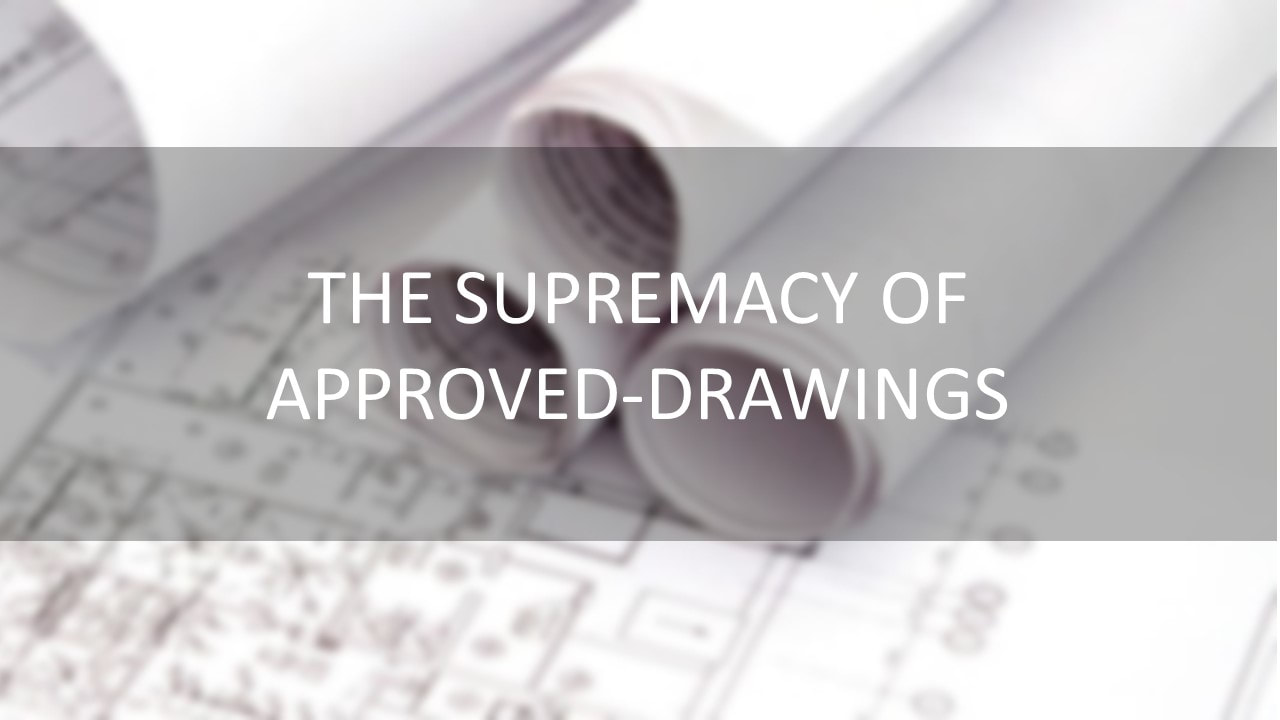THE SUPREMACY OF APPROVED-DRAWINGSThis writing is to guide QS, contractors and graduate-architects into understanding the various drawings…
In the profession of an architect, it is common to know that there are various issuance of drawings, originated from his office such as, Schematic-Drawings (sometimes called sketch-drawing), BP-Drawings, Bomba-Drawings, SPA-Drawings, Tender-Drawings, Construction-Drawings, Shop-Drawings and As-built Drawings. What are these exactly, or rather legally? There are three-statutory provisions that make a ‘drawing-legal’, means the architect will have to sign on it declaring, ‘certify that […] are in accordance to the UBBL 1984 and […] accept full responsibility’[1]. One, the Uniform Building Bylaws 1984 (UBBL), the Housing Development (Control and Licensing) Act 1966 (HDA) and the Contracts Act 1950. The moment the architect submitted his Schematic-Drawings for the consideration of the local authorities, including the fire-departments, these Schematic-Drawings had been elevated to become BP-Drawings and Bomba-Drawings, respectively. Both are construed as a ‘legal-document’ undertakings of liability by the architect to the public (authorities). Collectively, once ‘approved’ it is known as Approved-Drawings. Since it is an undertaking, it has to conform to every terms of the law, failing which the architect is liable for professional-negligence and misconduct, tantamount to criminal charges. That is the degree and gravity of compliance. The Approved-Drawings were to be translated into SPA-Drawings. In essence, it is supposed and legally should be an extract of the Approved-Drawings. In a nutshell, it is supposed to be the Approved-Drawings in manageable sizes to be inserted into the Sales and Purchase Agreement SPA between the Vendor and the House-buyer under the provision of the HDA. Therefore, it has no-further undertakings required by law, i.e. the HDA, thus, architect do not need to sign on it. The same Approved-Drawings were to be expended to include ‘blow-up’ detailing for the contractor to tender and thus, the name Tender-Drawings. As such it is the same Approved-Drawings and any significant changes will rendered the entire tender illegal and voidable-contract, ab-initio. A contract cannot be upheld if the nature of the contract is illegal, i.e. without the Approved-Drawings. On the same note, architect do not need to sign on these drawings. Similarly, when the contractor is appointed, the same Tender-Drawings must now, be elevated to be the Contract-Drawings and Construction-Drawings. Constructing a building with Construction-Drawings and contract-binding with Contract-Drawings that were differed from the Approved-Drawings will end up with colossal of contractual issues, not only to the contractor and employer but the vendor and its purchaser as well. Ultimately, to get strata-title, under the Strata Title Act 1985[2] and Strata Management Act 2013[3], the architect has to undertake that ‘the parcels constructed in accordance to the approved plans’. As-built Drawings that differed from Approved-Drawings are prima-facie of the architect ‘sleeping on the job’. Thus, you don’t need the architect to sign on the Contract-Drawings, As-built drawings and Construction-Drawings. Having said that, there is also something called the ‘Shop-Drawings’, and this ‘creature’ is not meant to be used as Construction-Drawings. Only ‘lazy-architect’ will use ‘shop-drawings’ as construction-drawings. It is also, illegal to append the Architect’s title-block in shop-drawings, simply because, it is not-prepared by him. It is prepared by specialist-contractors, manufacturers and generally, contractors. Why on earth must it contain the architect’s title-block? The correct application of shop-drawings is to be incorporated into the architect’s construction-drawings and not the other way around. Legally, contractor must not build based on drawings not specified as construction-drawings. As such, do you now, see how important is the Approved-Drawings? The only drawings that must be approved, be tendered and be built by it! Nothing else matter… Postscript: Vincent Tan wrote, ‘We found the contractors does not followed As-built drawing. Meaning what was supposed to be installed was not consistent with the As Built. Can the developer come back and say " we will amend the as built drawings" to make it consistent with actual site installation?’... this question required me to write more about ‘As-Built Drawings’. The meaning of ‘As-Built’ is a prima-facie of what has been built on site, itself an evidence if it does not reflect compliance to ‘Approved-Drawings’, it is entirely illegal and caused ripple across the myriad statutory obligations contravening these legislatures from UBBL 1984, HDA1996, STA 1964 to SMA 2013. It is common for the local authority to request the architect to submit ‘As-Built’ prior to CCC inspection, as a short-cut to amendment of Approved-Drawings. This has since rebuked in the ‘Highland Tower’ Case, where the court held that the practice of ‘As-Built’ is liked ‘holding ransom’ against the authorities compelling them to accept the ‘illegality’ wholesale, to make it legal. Thus, such unhealthy practices are still ‘rampant’. So, the answer to Vincent’s question is ‘Yes’ as developer can use ‘As-built’ to be ‘legalized’ by authorities, since they have the rights under UBBL to amend the ‘Approved-Drawings’ to reflect the ‘As-Built’. Thus, the practical use of the ‘As-Built’ is when an architect really needs to know an existing structure to work on it as renovation or makeover. --------------------------------------------------- [1] UBBL 1984, 2nd Sch. Form-A; s.6UBBL1984 [2] S.9(1)(b)(i): certified by professional architect [that] building constructed in accordance with [approved-plans] to which permission was given. [3] S.6(3)
2 Comments
Vincent tan
3/26/2021 04:21:29 am
We found the contractors does not followed As built drawing . Meaning what was supposed to be installed was not consistent with the As Built. Can the developer came back and say " we will amend the as built drawings" to make it consistent with actual site installation.
Reply
David Yek
3/27/2021 07:09:20 am
this question required me to write more about ‘As-Built Drawings’. The meaning of ‘As-Built’ is a prima-facie of what has been built on site, itself an evidence if it does not reflect compliance to ‘Approved-Drawings’, it is entirely illegal and caused ripple across the myriad statutory obligations contravening these legislatures from UBBL 1984, HDA1996, STA 1964 to SMA 2013. It is common for the local authority to request the architect to submit ‘As-Built’ prior to CCC inspection, as a short-cut to amendment of Approved-Drawings. This has since rebuked in the ‘Highland Tower’ Case, where the court held that the practice of ‘As-Built’ is liked ‘holding ransom’ against the authorities compelling them to accept the ‘illegality’ wholesale, to make it legal. Thus, such unhealthy practices are still ‘rampant’. So, the answer to Vincent’s question is ‘Yes’ as developer can use ‘As-built’ to be ‘legalized’ by authorities, since they have the rights under UBBL to amend the ‘Approved-Drawings’ to reflect the ‘As-Built’. Thus, the practical use of the ‘As-Built’ is when an architect really needs to know an existing structure to work on it as renovation or makeover.
Reply
Your comment will be posted after it is approved.
Leave a Reply. |
I am sharing these information with a caveat that these information is for educational purpose only and shall not be taken as an advice be it legal or otherwise. You should seek proper advice to your case with the relevant professionals. The author cannot guarantee the accuracy of the information so provided here.
Archives
March 2024
Categories
All
|
- Home
- About
-
Practice
-
DYA + C
-
Consultant
-
Educator
- Author I am...
- Speaking Engagement >
- Attempting Law School
- Journey in USM(Arch) >
- Discourse in Studio 6 >
-
d:KON 4
>
- Actors >
-
Acts
>
- Portraiture
- A Slice of Space Time
- Box of Installation of Lights
- Radio Misreading
- Grid of Destinies
- Shelter
- Anatomy of Pain
- Tensigrity of Ego
- Of Prisons and Walls
- Forest of Nails
- Curtain of Fears
- Dissolution of the Ego
- If it's Ain't Broken it's Ain't Worth Mending
- Flight of Freedom
- Cross of Complexity and Contradiction
- interrogation
- Stage >
- Play
- Approach
- Galleria >
- External Critique >
- Philosophy
- Codes Regulations & Standards >
- Photo Essays
- Contact




 RSS Feed
RSS Feed
